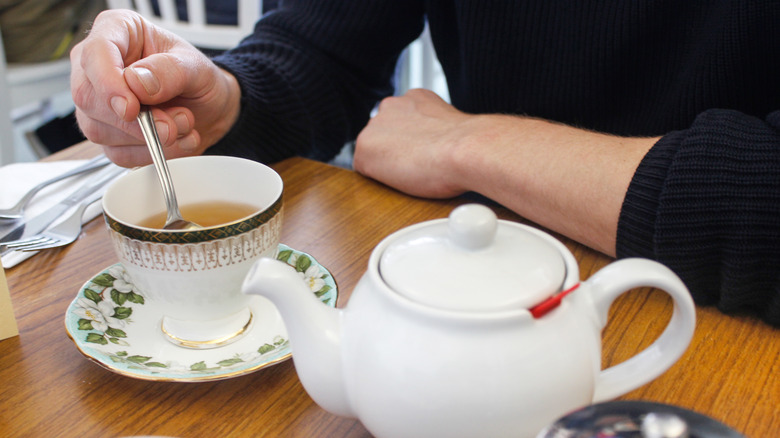Before You Drink Tea, Make Sure You Stir It The Proper Way
There's apparently a lot to consider when having a cup of tea: pinkies out or in, spoon on the saucer or table, milk added before or after. Those things matter when drinking the beverage in public, especially in a traditional English afternoon tea setting. Many tea-centric societies have their own customs regarding etiquette and tradition, but at some point, practicality enters the conversation.
There's a proper way to stir hot liquids like tea, and it combines common sense with manners. What you don't want to do is stir tea in a circular motion when blending in sugar and milk. It's a faux pas for several reasons. First, the force of rotating your spoon around the cup could easily send hot tea swirling over the rim, making a mess and potentially scalding your fingers. Next, unless you're particularly accomplished in gentle teacup stirring, the spoon may clang against the porcelain or ceramic sides of the cup, disrupting what's usually considered a calm, relaxing ritual.
Finally, the rush of circular motion in the teacup potentially affects how the sugar dissolves. A continual whirling pattern can create a vortex-like movement of liquid, trapping loose or cubed sugar and sending it to the bottom of the cup rather than dissolving and dispersing evenly into the hot liquid. The ideal stirring technique is instead a gentle glide between the 12 o'clock and 6 o'clock positions within the cup.
Past informs present when drinking tea
With the back-and-forth stirring technique, you'll be minding your manners while achieving a manageable, perfectly sweetened cup of warm, soothing tea. A few glides between the noon-to-six positions is all it takes, without touching the sides. And by all means, place the spoon on the saucer when finished, ideally to the right of the cup.
If you prefer a milky tea with your scones, cakes, and finger sandwiches, no worries — there's also etiquette for adding milk. The proper time to introduce milk into a cup of hot tea tends to vary regionally or even by social class, though less so than in past generations. Depending on who's telling the story, milk comes after the tea in high-end British social gatherings, due to practices dating back to the 1700s.
More expensive bone china cups, invented to withstand heat, were a symbol of wealth and status in high society. Pouring the tea first allowed time to admire teacup designs, before adding the milk and commencing to drink. Meanwhile, less expensive earthenware vessels tended to shatter and needed milk first in the bottom of the cup to cool and temper the hot liquid. Besides those remnants from yesteryear, one practical thing comes from pouring tea first: You can better judge how much milk to add, then stir it in with the sugar in a vertical noon-to-six motion.

